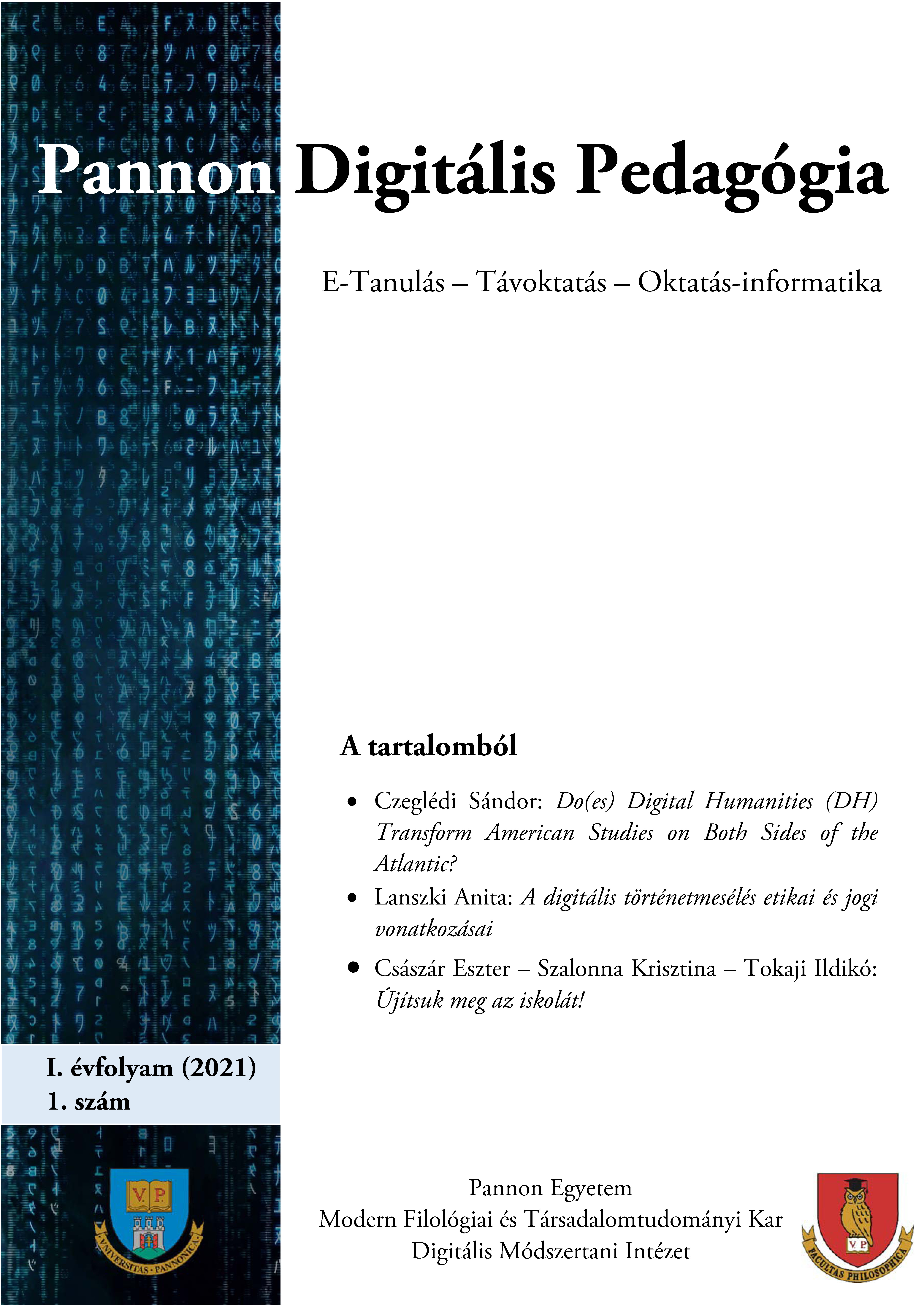A digitális oktatás face-to-face szóbeli kommunikációjának jellemzői és illemtana
DOI:
https://doi.org/10.56665/PADIPE.2021.1.3Keywords:
e-learning, face-to-face, oral communicationAbstract
In this study, I focus on the etiquette of communication in e-learning situations, caused by the SARS-CoV-2 pandemic in 2020/21. Online communication has huge literature and a wide wariety of platforms. Still there are few works, that aims the examination of the cahrecteristics of the-face-to face communication in the online space. The purpose of the study is to examine the interpersonal connections, formed during the digital education. The research is focusing on the teachers experiences. The collecting of datas were executed by an online questionnaire. The particippants were teachers from elementary schools and high schools (n=140). The survey examined the expectations and experiences about the face-to-face communication in e-learning situations. Furthermore it contained questions about the used or prefered platforms and motivational tools to maintain the effectice education. Most of the experiences were negative about the digital education. Issues whit the usage of different platforms, and time management were common problems. Appying the basic rules of network etiquette also encountered some difficulties (using camera and microphone). According to the results, it appears that hungarian public education lacks a formal protocoll, wich can be followed during times when schools have to work online. The absence of such protokol makes the teachers work, and communication with the students more difficult, resulting in a decrease in the efficiency of education.
References
Bálizs R., Klojbert B., Németh A., Takács Á. (2017) Netikett és az E-etikett a digitális együttélés szabályai, csoportos beadandó feladat. https://burotika.hu/netikett-es-az-e-etikett-2017/ (megtekintve: 2020. 09. 13.).
Beißwenger, M. (2015) Sprache und Medien: Digitale Kommunikation. (letöltve: 2020. 09. 13.)
Connor, P. (2015) Netiquette: Ground Rules for Online Discussions. https://tilt.colostate.edu/TipsAndGuides/Tip/128 (megtekintve: 2020. 07. 23.).
Fiedler, M. (2008) Virtuelle Face-to-Face-Kommunikation: Morphing von Online- und Offline-Repräsentanz in virtuellen Welten. https://www.wiwi.uni-passau.de/fileadmin/dokumente/fakultaeten/wiwi/lehrstuehle/fiedler/publications/face-to-faceFiedlerZFO_FINAL.pdf (megtekintve:2021. 05. 17.).
Forgó S., Komló Cs. (2015) Blended learning, tudásszervezés, hálózatalapú tudásmegosztás. Eger: Eszterházy Károly Főiskola.
Kismihók G. (2011) Rugalmas tanulás, rugalmas munkavégzés. Az ontológia alapú tartalommenedzsment lehetőségeinek kiaknázása. Doktori disszertáció. Budapest: Budapesti Corvinus Egyetem Gazdálkodástani Doktori Iskola.
Krutsch, D. (2015) Kommunikation über das Internet oder Face-to-Face? Ein Vergleich. https://www.grin.com/document/308493 (megtekintve: 2020. 10. 20.).
Kulcsár Zs. (2009) Hálózati tanulás. http://matchsz.inf.elte.hu/tt/docs/Kulcsar-Zsolt-Halozati-tanulas.pdf (megtekintve: 2021. 06. 04.).
Nádori G. (2020) Tanítás karantén idején – a digitális iskolai etikett. http://tanarblog.hu/cikk/tanitas-karanten-idejen-a-digitalis-iskolai etikett (megtekintve: 2021. 04. 25.).
Pankász B. (2016) Online oktatási környezet és IKT tényezők összehasonlító vizsgálata a felsőoktatásban. Doktori (PhD) értekezés. (megtekintve: 2021. 06. 04.).
Papp-Danka A. (2011) Az online tanulási környezet fogalmának értelmezési lehetőségei. Oktatás-Informatika. 3(1–2): 43–48.
Parapatics A., Vígh-Szabó M. (2020) A magyar nyelv tantárgy digitális oktatásának támogatása. Globális kihívás – lokális válaszok. A koronavírus (COVID19) gazdasági és társadalmi összefüggései és hatásai (szerk. Kovács L.) Szombathely: Savaria University Press, 429-441. (megtekintve: 2021. 05. 10.).
P. Szilczl D. (2016) Digitális face-to-face. Vigilia 2016/6, 410–417. https://vigilia.hu/pdfs/Vigilia_2016_06_facsimile.pdf#page=12 (megtekintve: 2020. 10. 09.).
Rusch, G. (1998) From Face-to-Face to Face-to-"Face". Zehn Schritte von der mündlichen Kommunikation zum Cyberspace. https://www.uni-siegen.de/infme/start_ifm/downloads/rusch/rusch-face-to-face.pdf (megtekintve: 2021. 06. 04.).
Simonics I. (2011) Az elektronikus kommunikáció problémái. http://uni-obuda.hu/e-bulletin/Simonics_2.pdf (megtekintve: 2021. 05.17.).
(W1) https://www.nkp.hu/tankonyv/magyar_nyelv_9_nat2020/lecke_01_007 (megtekintve: 2021. 05. 15.).
(W2) http://mdoe.hu/digitalis-oktatas/tavoktatas-tanari-szemmel/ (megtekintve: 2021. 05. 22.).
(W3)https://www.oktatas.hu/kozneveles/ajanlas_szemelyes_talalkozas_nelkuli_oktatas_neveles_modszereire/digitalis_oktatasi_tartalmak (megtekintve: 2021. 05. 24.).
(W4) https://gimnazium.jezsu.hu/index.php/digitalis-oktatas/szabalyzatok/item/1522-meet-es-goole-classroom-illemtan (megtekintve: 2021. 05. 22.).
Downloads
Published
Versions
- 2023-01-17 (2)
- 2021-09-10 (1)

